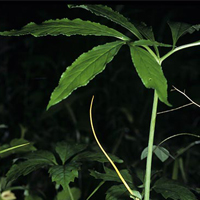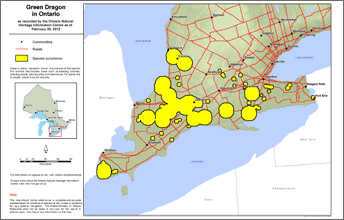Green dragon
Scientific name: Arisaema dracontium

Cover photo credit: Allen Woodliffe
Status
Special Concern
“Special Concern” means the species lives in the wild in Ontario, is not endangered or threatened, but may become threatened or endangered due to a combination of biological characteristics and identified threats.
Date added to the Species at Risk in Ontario List
The Green Dragon was already assessed as a species of special concern when the Endangered Species Act took effect in 2008.
What it looks like
The Green Dragon is a perennial wildflower which grows 15 to 90 centimetres tall. There is usually just one long-stalked leaf divided into five to 13, sometimes as many as 21, elliptic to broadly lance-shaped leaflets.
A separate stalk holds the plant’s green-yellow blossom. A long narrow leaf-like cup surrounds the flower spike which protrudes beyond it evoking the idea of a dragon’s tongue. Numerous very small white flowers, lacking petals, are crowded onto the upper 15-centimetre length of the flower stem,. The fruit consists of a dense cluster of bright red or reddish-orange berries, with up to six light yellow or whitish seeds in each berry.
Where it lives
The Green Dragon grows in somewhat wet to wet deciduous forests along streams, particularly maple forest and forest dominated by Red Ash and White Elm trees.
Where it’s been found in Ontario
Primarily a plant of the southern United States, the Green Dragon is found from the Great Lakes region and southern Quebec east to the Atlantic coast, south to Florida and the Gulf coast, and west to Texas and Nebraska. In Ontario, it is believed to still occur at about 30 to 35 sites in the southwestern part of the province.
View a larger version of this map (PDF)
What threatens it
Historical records suggest that Green Dragon was once more widespread in the province, occurring at about 85 locations. It may have declined as forests were cleared.
Actions we are taking
Special concern species do not receive species or habitat protection.
Management plan
A management plan advises the ministry on ways to ensure healthy numbers of the species return to Ontario.
Read the management plan (June 28, 2013).
Government response statement
A government response statement outlines the actions the government intends to take or support to help recover the species.
Read the government response statement (March 7, 2014).
What you can do
Report a sighting
- Report a sighting of an endangered animal or plant to the Natural Heritage Information Centre. Photographs with specific locations or mapping coordinates are always helpful.
Volunteer
- Volunteer with your local nature club or provincial park to participate in surveys or stewardship work focused on species at risk.
Be a good steward
- Private land owners have a very important role to play in species recovery. You may be eligible for stewardship programs that support the protection and recovery of species at risk and their habitats.
- Green Dragon are pollinated by flying insects. Pollinators are in steep decline across the globe and they play a key role in the survival of many of Ontario’s rare plants. For information on how you can help scientists monitor pollinator populations in Ontario visit: www.seeds.ca/proj/poll.
Report illegal activity
- Report any illegal activity related to plants and wildlife to 1-877-TIPS-MNR (847-7667).
Quick facts
- The Green Dragon’s root is bitter tasting and poisonous unless specially prepared, but it was used medicinally by Aboriginal people and European settlers.
- The Green Dragon flowers in May and June, pollinated mainly by small insects.
- Green Dragon plants often grow in the same locations as the more common Jack-in-the-Pulpit, to which they are related.
